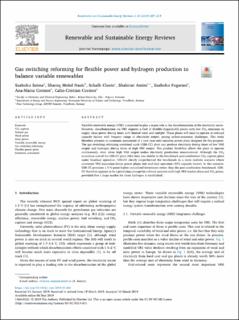Gas switching reforming for flexible power and hydrogen production to balance variable renewables
Szima, Szabolcs; Nazir, Shareq Mohd; Cloete, Schalk Willem Petrus; Amini, Shahriar; Fogarasi, Szabolcs; Cormos, Ana-Maria; Cormos, Calin-Cristian
Peer reviewed, Journal article
Published version
Permanent lenke
https://hdl.handle.net/11250/2688992Utgivelsesdato
2019Metadata
Vis full innførselSamlinger
- Publikasjoner fra CRIStin - SINTEF AS [5801]
- SINTEF Industri [1566]
Originalversjon
Renewable & Sustainable Energy Reviews. 2019, 110 207-219. 10.1016/j.rser.2019.03.061Sammendrag
Variable renewable energy (VRE) is expected to play a major role in the decarbonization of the electricity sector. However, decarbonization via VRE requires a fleet of flexible dispatchable plants with low CO2 emissions to supply clean power during times with limited wind and sunlight. These plants will need to operate at reduced capacity factors with frequent ramps in electricity output, posing techno-economic challenges. This study therefore presents an economic assessment of a new near-zero emission power plant designed for this purpose. The gas switching reforming combined cycle (GSR-CC) plant can produce electricity during times of low VRE output and hydrogen during times of high VRE output. This product flexibility allows the plant to operate continuously, even when high VRE output makes electricity production uneconomical. Although the CO2 avoidance cost of the GSR-CC plant (€61/ton) was similar to the benchmark post-combustion CO2 capture plant under baseload operation, GSR-CC clearly outperformed the benchmark in a more realistic scenario where continued VRE expansion forces power plants into mid-load operation (45% capacity factor). In this scenario, GSR-CC promises a 5 %-point higher annualized investment return than the post-combustion benchmark. GSR-CC therefore appears to be a promising concept for a future scenario with high VRE market share and CO2 prices, provided that a large market for clean hydrogen is established.

